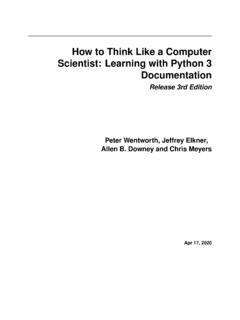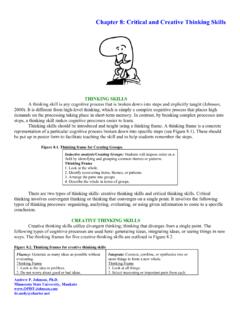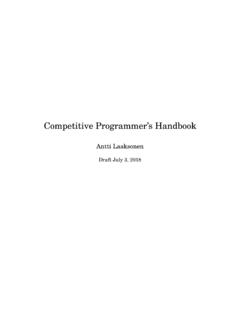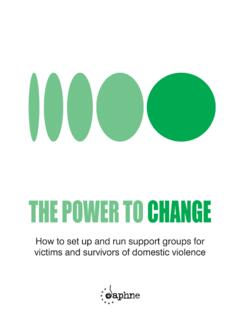Transcription of What Type of Learner Are You? - University of Connecticut
1 What Type of Learner Are You? Goal: Determine how you learn best so you can find more effective ways to study. Directions: Circle the best answer for each question. 1. If I have to learn how to do something, I learn best when I: a. Watch someone show me how. b. Hear someone tell me how. c. Try to do it myself. 2. When I spell, I verify accuracy by: a. Looking at the word to see if it looks correct. b. Sounding the word out in my head. c. Getting a feeling about the correctness of the spelling. 3. When asked to give directions, I: a. See the actual places in my mind as I say them or prefer to draw them. b. Have no difficulty giving them verbally. c. Have to point or move my body as I give them. 4. When I have to remember a list of items, I remember them best if I: a.
2 Write them down. b. Repeat them over and over to myself. c. Move around and use my fingers to name each item. 5. When solving a problem, I: a. Write or draw diagrams to see it. b. Talk myself through it. c. Use and/or move objects to help me think. 6. When I am adding numbers, I verify my answer by: a. Looking at the numbers to see if they are correct. b. Counting the numbers in my head or out loud. c. Using my fingers to get a feeling if it is correct. 7. When trying to recall names, I remember: a. Faces more easily than names. b. Names more easily than faces. c. The situation or the meeting more easily than names or faces. 8. Before going to sleep at night, I appreciate: a. The room is dark. b. The room is quiet. c. The bed feels comfortable. Results: Write in how many of your answers was each of the following letter choices: This document is intended strictly for educational purposes to be used by UConn students, staff and/or faculty.
3 A: _____ b: _____ c: _____. Now what? Look at the letter you scored the most responses in. Read and try some of the methods listed under the corresponding learning style. Read through the methods listed under the other learning styles as well! Try anything that you might work for you because we are a blend of each of these styles, just to different severities! Interpretation: If you had mostly a's, then you are a visual Learner . Sit in the front of the class or meeting so you can see everything. Sketch course content. Even the simplest sketch can help you remember ideas. List your tasks even the ones you have completed just to have the satisfaction of visually crossing out tasks done. Write notes on your favorite colored sticky-notes to help you remember and paste them around.
4 An uncluttered desk may help in clearing your mind to be able to study better. Write yourself encouraging notes and post them where you can see them. Create mind maps, flowcharts, or other graphic organizers. If you had mostly b's, then you are an auditory Learner . Tape record the class session and listen to your tape later for reference and repetition. It may also help if you listen to it casually while walking to class or before falling asleep. Read your textbook and notes aloud as you study. You could even record them as you do so. Teach yourself to read aloud in your mind without making sound. During exams, you can hear the test questions as well as see them. Study with a partner or in a group. When studying with others, you can hear what they say, and hear yourself teaching them as well.
5 This will reinforce your understanding of the material. Proofread your assignments out loud. If you had mostly c's, then you are a kinesthetic Learner . Sit where you can actively participate in classroom events and discussions. Take notes creatively. For instance, draw quick pictures in class that relates to the material being taught. Ask and answer questions before, during, and after class. Make models of the concepts whenever possible. Move around while you are studying. For instance, you can simply walk around the room. Study on a whiteboard. Draw flowcharts, mind maps, or simply rewrite the notes. Incorporate pictures of models, if possible. Make physical comfort a priority as you study. Make note cards and create sample tests that you can take for review.
6 This document is intended strictly for educational purposes to be used by UConn students, staff and/or faculty. STUDY TIPS FOR THE VISUAL Learner . High visual learners tend to learn information by seeing, whether through reading or watching. Reading textbooks, material on the board or on overhead projectors, as well as demonstrations and diagrams are helpful. The following list contains strategies for visual learners. 1. Write things down because you remember them better that way 2. Make study area visually appealing. 3. Look at people and professors when they talk. This technique will help you stay focused. 4. Most visual learners study better by themselves. 5. Take thorough notes in lectures and when studying textbooks. Review and revise notes after class, preferably immediately after class while you still remember a good deal of the lecture, to reinforce your knowledge.
7 6. Read assignments in 25 minute intervals (you lose 85% of your input after reading for 25 minutes). 7. When beginning a textbook chapter , read the chapter overview and summary first to get a general idea of the information. Then begin reading. 8. Underline main points in an eye-arresting color for example, neon highlighter 9. After 25 minutes, take a one-to-five minute break, and review underlined material. 10. Review your underlined/highlighted material after your break 11. Read for another 25 minutes, take a one-to-five minute break, and review underlined material. 12. Just before closing your book, review all underlined material read that day to reinforce your learning. 13. Write new vocabulary words on colored index cards (or write in color on white index cards) with short definitions on the back.
8 Carry these with you and review them at odd moments or whenever you have spare time. STUDY TIPS FOR THE AUDITORY Learner . High auditory learners benefit from listening hearing the information and processing it accordingly. Auditory learners focus easily on sound and have good memory of what they have heard through lectures or on tape. The following hints are useful for auditory learners. 1. Try studying with a friend so that you can talk out loud and hear the information. 2. Recite out loud the things you want to remember. 3. Tape your lectures and review your notes while listening to your tape. This gives a double auditory input. Transfer your notes to index cards that you can carry with you and review aloud. 4. Read assignments for 25 minutes (no more- you lose 85% of your input after the first 25 minutes.)
9 When beginning a textbook chapter , read the summary to get a general idea of the information. Then begin the reading (you might even try reading aloud). 5. Underline the main points in an eye-arresting color for example, neon highlighter This document is intended strictly for educational purposes to be used by UConn students, staff and/or faculty. 6. After 25 minutes, take a one-to-five minute break, and review underlined material. 7. Review your underlined/highlighted material after your break 8. Read for another 25 minutes, take a one-to-five minute break, and review underlined material. 9. Review aloud from the beginning of underlined materials. Repeat. STUDY TIPS FOR THE KINESTHETIC Learner . High kinesthetic learners acquire knowledge best through manipulation doing, touching, hands on, and writing techniques.
10 Primary kinesthetic learners would benefit from finding their secondary learning mode and using directions for either visual or auditory in conjunction with the following hints. 1. Write things down because you remember them better that way. 2. Try studying with a friend so that you can talk out loud and hear the information. 3. When memorizing, pace or walk around while reciting to yourself or looking at a note card, and also try writing the information on a desk with your fingers. 4. Keep something in your hand that is malleable. Knead or tap to a rhythm as you study. As much as you can, translate what you are learning into something that can be touched. Typing is helpful, as is writing your notes. If possible, type your notes on index cards. Eating, drinking, chewing gum, and listening to music are also helpful.







